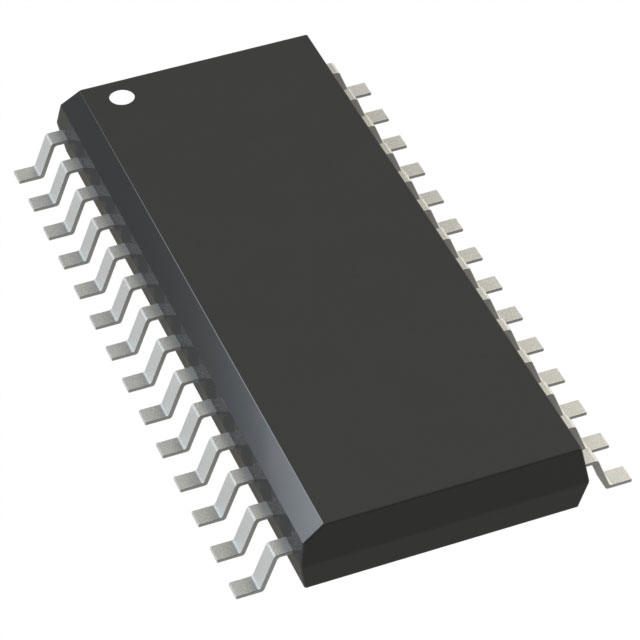

Microchip Technology
PIC18F2682-I/SO
Microcontrollers
PIC18F2682-I/SO
685-PIC18F2682-I/SO

Microchip Technology-PIC18F2682-I/SO-datasheets-5695345.pdf
IC MCU 8BIT 80KB FLASH 28SOIC



.png?x-oss-process=image/format,webp/resize,p_30)


PIC18F2682-I/SO Description
Microchip Technology's PIC18F2682-I/SO is a microcontroller unit (MCU) that belongs to the PIC18F series. This MCU is designed for a wide range of applications, including industrial control, automotive, and consumer electronics.
Description:
The PIC18F2682-I/SO is a 40-pin integrated circuit (IC) that features a high-performance, 8-bit microcontroller core. It is based on the enhanced mid-range PIC18 architecture, which provides high code density, advanced peripherals, and a variety of memory configurations. The device operates with a supply voltage range of 2.0V to 5.5V and has a maximum operating frequency of 40 MHz.
Features:
- Enhanced mid-range PIC18 architecture with high code density and advanced peripherals
- 40-pin package with 2.0V to 5.5V supply voltage range
- Maximum operating frequency of 40 MHz
- Up to 63,488 bytes of Flash program memory
- Up to 3,840 bytes of RAM (including the stack and registers)
- Up to 1,024 bytes of EEPROM memory
- 16-bit wide instruction word and 8-bit wide data bus
- On-chip debugging and programming support with in-circuit serial programming (ICSP) and debugger (ICD) interfaces
- Advanced peripherals, including UART, SPI, I2C, and Parallel Master Port (PMP)
- Up to 35 general-purpose I/O (GPIO) pins with various input/output options and alternate functions
- Enhanced CCP module for PWM, capture, compare, and high-speed output modes
- Power-on reset (POR), brown-out detect (BOD), and low-voltage programming (LVP) features
- Internal oscillator with PLL for high-frequency operation
- Optional watchdog timer (WDT) and real-time clock (RTC) with alarm
Applications:
- Industrial control systems for motor control, sensor interfacing, and data acquisition
- Automotive applications, such as body control modules, instrument clusters, and infotainment systems
- Consumer electronics, including home appliances, gaming consoles, and smart devices
- Telecommunication systems, such as modems, routers, and VoIP devices
- Medical equipment, such as monitoring devices, diagnostic tools, and portable instruments
- Security systems, including access control, surveillance cameras, and alarm panels
- Renewable energy systems, like solar panel monitoring, battery management, and energy storage control
- Robotics and automation systems for control, sensing, and actuation
- IoT devices and smart sensors for data collection, processing, and communication
- Embedded systems in various applications, where a combination of processing power, peripherals, and memory is required.
Tech Specifications
Core Processor
Program Memory Type
Product Status
Supplier Device Package
EEPROM Size
Package / Case
REACH Status
Mfr
Voltage - Supply (Vcc/Vdd)
RoHS Status
Moisture Sensitivity Level (MSL)
Speed
Operating Temperature
RAM Size
ECCN
Number of I/O
Peripherals
Mounting Type
Oscillator Type
Series
Core Size
Connectivity
Program Memory Size
HTSUS
Package
Data Converters
Base Product Number
Unit Weight
Product
ADC Resolution
RoHS
Supply Voltage - Min
Tradename
Processor Series
Data RAM Type
Maximum Clock Frequency
Height
Maximum Operating Temperature
Supply Voltage - Max
Width
Data RAM Size
Interface Type
Core
Mounting Style
Data Bus Width
Minimum Operating Temperature
Number of Timers/Counters
Moisture Sensitive
Length
Number of I/Os
Data ROM Size
Number of ADC Channels
Data ROM Type
USHTS
PIC18F2682-I/SO Documents
Download datasheets and manufacturer documentation for PIC18F2682-I/SO
 PIC18F268x, 468x Revision A1 Errata
PIC18F268x, 468x Revision A1 Errata  Mult Devices Bond Wire 09/Mar/2018
Mult Devices Bond Wire 09/Mar/2018  PIC18F(2, 4)zzz Programming Specification PIC18F268x, 468x Data Sheet
PIC18F(2, 4)zzz Programming Specification PIC18F268x, 468x Data Sheet  MBB/Label Chgs 16/Nov/2018 Label and Packing Changes 23/Sep/2015
MBB/Label Chgs 16/Nov/2018 Label and Packing Changes 23/Sep/2015  PIC18F2682 Development Tool Selector
PIC18F2682 Development Tool Selector  PIC18F(2, 4)zzz Programming Specification
PIC18F(2, 4)zzz Programming Specification  Errata/Datasheet Update 07/Aug/2014
Errata/Datasheet Update 07/Aug/2014  Microchip CA Prop65 Microchip RoHS Microchip REACH
Microchip CA Prop65 Microchip RoHS Microchip REACH Relevant Search
PIC16C711-20E/PTSC80251G2D-24IBPIC16F526T-I/SLPIC18F2458-I/SPPIC18F67K22-I/MRRSLDSPIC33EP32GP502-E/SOPIC24EP512GP202-I/MMPIC24F08KL200-E/STDSPIC33EV64GM004-E/PTPIC16F1779-E/MVPIC24FJ64GA705-I/M4ATSAME51J19A-AFTPIC18F47Q10-E/MPPIC18F15Q41-I/SSPIC18F55Q43-E/PTPIC16F15274-I/MPDSPIC33CK512MP608-I/PTAVR64EA28-I/SP
Shopping Guide

Payment Methods
Payment Methods include Prepayment TT (bank transfer), Western Union, and PayPal. Customers are responsible for shipping costs, bank charges, customs duties and taxes.


Shipping Rate
Shipments are made once a day around 5pm, excluding Sundays. Once shipped, the estimated delivery time is usually 5-7 business days, depending on the courier you choose.

Delivery Methods
Provide DHL, FedEx, UPS, EMS, SF Express and Registered Airmail International Delivery Service


















.png?x-oss-process=image/format,webp/resize,h_32)










